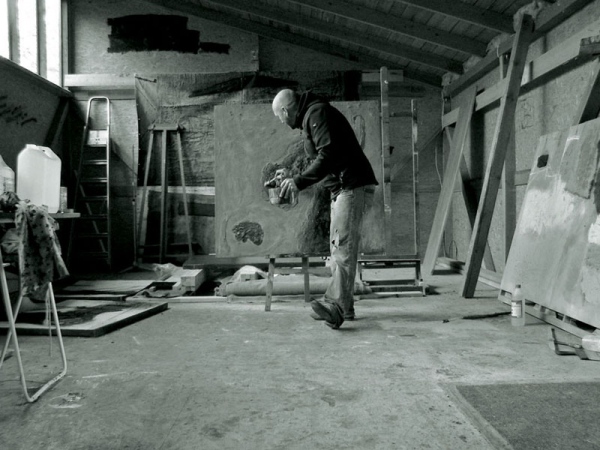-
In 2008 Verners Lazdans graduated from the Painting department of the Latvian Academy of Art with a series of works revealing his interest in human / animal interaction and the incomprehensible in nature – in savagery that contains much undiscovered pre-programmed genuineness.
Painting with a succulently plastic gesture on grey monochrome fields, the artist models original forms-structures that remind us of fantasy creatures. We have here both monumental scope and laconism. The image has become a symbol for the depiction of the inner essence, the centre of the work. There are no descriptive surroundings such as landscape or interior. Everything is subjected to the representation of the inner essence.
The works may be interpreted as an idea of the alien, inscrutable part of nature as well as a metaphor on the human/animal boundary, on the subconscious and its primeval force.
-
-
Poet and ploughman – a contrast mentioned in one of the works by George Sand* these days no longer seems to be the incompatible division between “life in primitivism” and “life in practicality”(Sand’s notions) created in the age of romanticism. It can be useful in understanding the works of Verners Lazdāns. The superiority of nature, the imagination and creative freedom over culture, the mechanical, reason and laws, has been embodied both in the exhibition works and the artist’s approach. During the creation of his works he seems to echo the romantic myth of the artist as drawing inspiration from the wild yet fascinating power of nature in the attempt to unravel its “noble secrets” and aestheticise the uncontrollable elements.
The presence of organic forms is one of Verners Lazdāns’ motifs although, as we can see, they are not naive flower compositions, rushing waterfalls or something similar that we have become used to perceiving as examples of the “beauty” of nature. We should rather say that the artist reveals the process of creation and birth, which is quite a long way from the aestheticised forms of creativity. Instead of a sparkling spring, recalling Bruce Nauman’s famous work “Self-portrait as a fountain”, there is kneaded clay which still preserves the touch of the artist’s rough and firm hands. The robust character of the works seems to confirm that writing poetry in some sense really could be compared to ploughing furrows if we can free ourselves from the view of art as something a priori sophisticated and ethereal. Mud, just ploughed earth, the power with which the artist works on the material – these are metaphors that, incidentally, also contain erotic meaning, which, although not forming the “overtone” of the exhibition, is present nevertheless.
Interestingly, the artist admits that his sources of inspiration have been photographs by the Hubble Space Telescope, the stalactite caves in the Crimea and various other natural formations. (We should mention that the list was compiled before the current political developments.) In the photographs from outer space we can see undefined forms without clear anthropomorphic characteristics and they continue to develop in the artist’s works too – in his canvases and sculptures. The rejection of the human scale is further reinforced by the fact that in both cases – in the images taken from the cosmos and in the stalactite caves that have been formed over thousands of years – the human view is made insignificant; the man-made yardstick for the understanding of time and space ceases to work here.
Jana Kukaine, art critic
*The work referred to is George Sand, Francois le Champi, Vara Vīksna. 2008.
-

